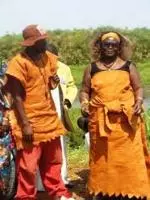Tanzania Weather and Climate
Tanzania Weather and Climate are always favourable for tourism in Tanzania. This page therefore give you all the details about Tanzania geography and how it affects climate and weather in Tanzania.
Tanzania lies so close to the equator that seasonal variations in temperature are not extreme. The elevation in the north is such that it doesn't ever get too hot.
While the weather is best between June and September, don't plan on seeing any animals in the Serengeti - they will have migrated to Kenya. September-March is a good time to go, but avoid April and May, when the weather is at its rainiest.
As you approach the top of Kilimanjaro, temperatures can be well below freezing year-round, especially at night. Many of the northern wildlife reserves are about 10 degrees F/5 degrees C cooler year-round than elsewhere. Take along a heavy sweater and a windbreaker or jacket.
Owing to the country's widely varying topography, Tanzania's climate displays great range of regional differences.
Tanzania Weather and Climate along the coast.
Coastal Region, Dar es Salaam, Limdi, Mtwara and Tanga, and the off-shore Islands of Mafia, Pemba, and Unguja is tropical with relatively high humidity. The average temperature, which is moderated by the sea breeze, especially on the islands, ranges between 27 and 29 degree celcius.
Tanzania Weather and Climate in the Central, Northern and Western: .
Around Mwanza Kagera, Kigoma, Shinyanga and Tabora, the climate is modified by highland plateau; low humidity with temperatures ranging between 20 and 27 degree celcius during the cooler months of June and August. The temperature can reach as high as 30 degree celcius and higher between the months of December and March.
Tanzania Weather and Climate in Northeast and Southwest: .
In the mountainous areas of the Arusha, Kilimanjaro and Mara region and Mbeya, Rukwa, Iringa and Ruvuma, and Makonde Plateau (Newalla, Masasi, Nachingwea and Tunduru), the temperature occasionally drops below 15 degree celcius at night during the months of June and July. In the area around Rungwe mountains the temperature can reach as low as 8 or 6 degree celcius.
Tanzania Weather and Climate in Central:
A large part of central regions (Dodoma and Singida) is semi-arid, receiving less that 500mm of rain annually. In contrast, the mountainous area in the north-east and south-west receive over 2000mm of rain annually. Along the coast (Dar es Salaam, Tanga, Lindi, Mtwara and Coastal Region) rainfall ranges between 1000 and 1900 mm.
Tanzania Weather and Climate in General: .
There are two rain seasons throughout the country: the long season from mid March through May, the short rain seasons falls during November, December, and January. The coolest months are from June to October, and the warmest are December to March.
Geography
Tanzania not only boasts the highest mountain in Africa, (Kilimanjaro is 19,340 feet) but the longest and deepest lake: Tanganyika. Because the lake is over 4,000 feet deep, it harbors many exotic looking species that are endemic.
Lake Victoria, Africa's largest lake, also borders this country. Covering an area of over 362,000 square miles, it is substantially larger than Kenya. Nearly a quarter of Tanzania is protected by national parks, hunting reserves and controlled zones.
The coast is not as exploited as that of Kenya, but remote beaches far north and south of Dar Es Salaam are beautiful.
What is being developed are the Indian Ocean islands. Zanzibar has undergone a total facelift within the past decade, with many new hotels, renovated historical structures, and much improved infrastructure, including connections to the mainland by air or hovercraft.
Mafia and Pemba Islands also have nice resort lodges and facilities for SCUBA divers. While it can be warm and humid on these islands, as well as the coast, the interior of Tanzania is crisp and ideal between June and September.
(April-May have heavy rains.) For many years most travelers have been confined to a northern circuit, but now there are new lodges in the south, especially in the Selous, the largest game reserve this side of Lake Chad. Ruaha is also fast being developed with wonderful wildlife and very scenic landscape. For the intrepid traveler, Mikumi, Katavi and Mahale Mountains are also worth visiting.
. Best time to visit to Visit Tanzania:
Tanzania can be visited year-round, although the best time for travelling is outside of the rainy season between June and October, when temperatures stay well below their summer peaks. Beach side locations like Zanzibar can be fine to visit during the hotter months of December to January, though hotels can book up early for the Christmas/New Year holidays.
. Required Clothing While Going to Tanzania
Tropical clothing is worn throughout the year, but in the cooler season, from June to September, jackets and sweaters may be needed, especially in the evenings. Clothing appropriate to temperatures below zero is required on the higher slopes of Kilimanjaro and Meru.
Also note that it can get very cold at night on the Ngorongoro Crater and early morning game drives may be chilly before the sun comes up.
Other Related Pages
Entertainment in Tanzania › |
How to Travel to Tanzania › |
Tanzania Visa › |
Weather in Tanzania › |
Questions and answers about Tanzania › |
Museum › |
Pangani Town › | Pemba Town › | Tanga Town › | Moshi Town › | Mtera › | Mwanza Town › | Kondoa Town › | Lushoto Town › | Dodoma Town › | Babati Town › | Geita Town › | Handeni Town › | Iringa Town › | Karogwe Town › | Kasanga Town › | Kasulu Town › | Kidika Town › | Kigoma Town › | Kilindoni Town › | Kilwa Masoko Town › | Koani Town › | Lindi Town › | Mahenge Town › | Manyoni Town › | Mbamba Town › | Mbeya Town › | Mikindani Town › | Town Schools and Colleges› | Dar es Salaam City Guide › | Zanzibar Visitors Guide › | Bukoba › |
Recent Articles
-
Garam Masala Appetizers ,How to Make Garam Masala,Kenya Cuisines
Sep 21, 14 03:38 PM
Garam Masala Appetizers are originally Indian food but of recent, many Kenyans use it. Therefore, on this site, we will guide you on how to make it easily. -
The Details of the Baruuli-Banyara People and their Culture in Uganda
Sep 03, 14 12:32 AM
The Baruuli-Banyala are a people of Central Uganda who generally live near the Nile River-Lake Kyoga basin. -
Guide to Nubi People and their Culture in Kenya and Uganda
Sep 03, 14 12:24 AM
The Nubians consist of seven non-Arab Muslim tribes which originated in the Nubia region, an area between Aswan in southern







New! Comments
Have your say about what you just read! Leave me a comment in the box below.